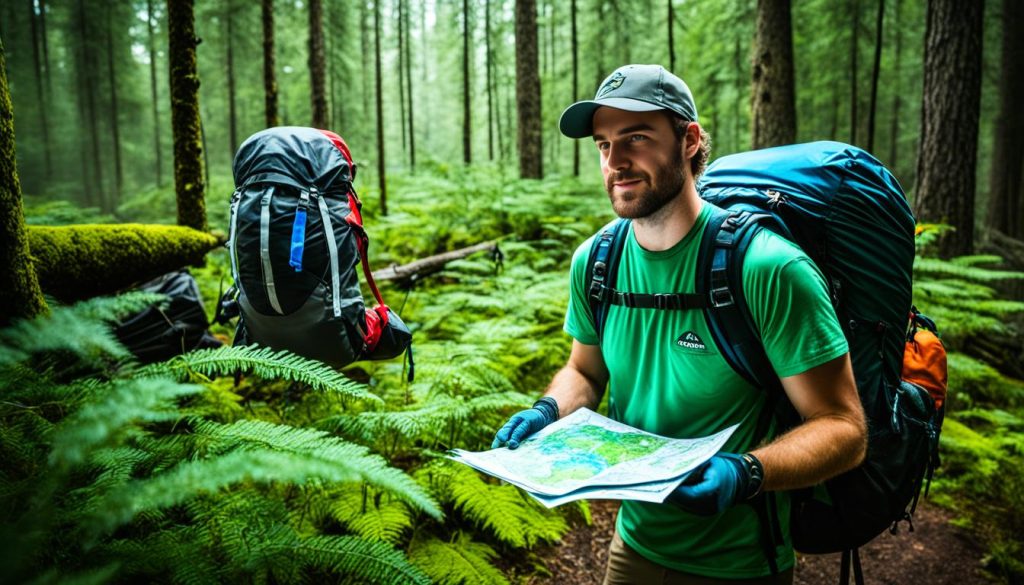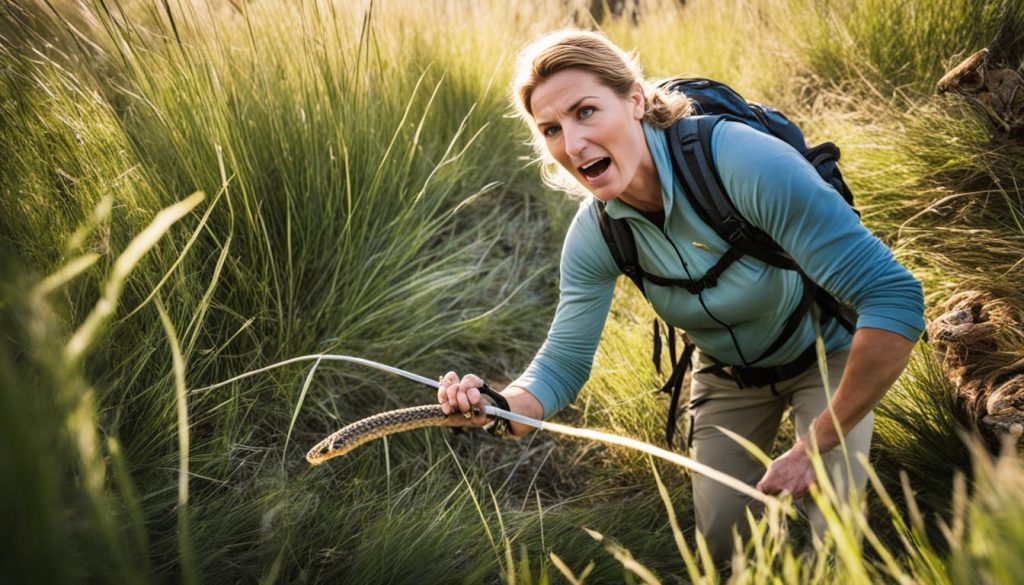Did you know that each year, there are an estimated 40,000 reported wild animal encounters in national parks and wilderness areas?
When venturing into nature’s untamed beauty, it’s essential to stay safe and well-prepared. Whether you’re hiking, camping, or simply enjoying the great outdoors, knowing how to safeguard yourself during wild animal encounters is crucial. By following the right precautions, you can navigate these encounters with confidence, awe, and respect for the wildlife that calls these places home.
Key Takeaways:
- Understanding wild animal behavior is essential for staying safe during encounters.
- General safety tips, such as making noise and carrying bear spray, can help prevent dangerous situations.
- Knowing how to react during specific encounters with snakes, moose, bears, mountain lions, and coyotes can make a difference.
- Always stay informed about the wildlife in the area you plan to visit and report any encounters to park rangers.
- Respecting the animals and their habitats is crucial for preserving their natural behavior and ensuring enjoyable future encounters.
Understanding Wild Animal Behavior
Before heading out on your outdoor adventure, it’s crucial to familiarize yourself with the behavior of wild animals. Regardless of how cute or harmless they may seem, it’s important to remember that these animals are still wild and unpredictable. To ensure your safety and the well-being of the animals, it’s essential to avoid provoking them in any way.
Avoid Feeding or Attempting to Pet Animals: While it may be tempting to feed or pet wild animals, it is highly discouraged. Feeding animals can disrupt their natural foraging behaviors and lead to dependency on humans, which can have harmful consequences for their health and safety. Additionally, attempting to pet wild animals can be dangerous for both you and the animal, as their instinctual behaviors can result in unintended harm.
Give Animals Their Space: When encountering wildlife, it is crucial to maintain a safe distance and respect their personal boundaries. Trying to approach or invade their space can make them feel threatened or defensive, potentially leading to aggressive behavior. Observing animals from a distance allows for a more authentic wildlife experience while minimizing the risk of dangerous encounters.
Avoid Provoke, Sneak Up On, or Scare Animals: Making sudden movements, sneakily approaching, or intentionally scaring wild animals can elicit fear or aggression responses. It’s important to be mindful of your actions and to treat their habitats with the utmost respect. By avoiding any actions that may disturb or provoke them, you can help create a harmonious and safe coexistence.
“Remember, wild animals are not pets or entertainers. They deserve our respect and admiration from a distance.” – Wildlife Conservation Society
By understanding and respecting wild animal behavior, you can significantly reduce the risk of dangerous encounters and contribute to the preservation of wildlife habitats. Always prioritize the safety and well-being of both yourself and the animals you encounter during your outdoor adventures.
General Safety Tips for Wild Animal Encounters
When venturing into the wild, it’s essential to prioritize your safety during encounters with wild animals. By following these general safety tips, you can stay safe and ensure a harmonious coexistence with the wildlife.
Making Noise and Avoiding Surprises
One of the most important safety measures is to make noise as you hike through the wilderness. This helps alert animals to your presence and prevents surprising them, which can lead to defensive or aggressive behavior. Make your presence known by talking, clapping your hands, or using a bear bell, especially in areas with dense vegetation or limited visibility.
Observing Animal Tracks and Droppings
Knowing what types of animals are in the area can greatly assist in avoiding potentially dangerous encounters. Watch for animal tracks and droppings along the trail, as they provide valuable clues about the presence and habits of wildlife. Educate yourself about the animal signs specific to the area you are exploring. This knowledge will help you stay alert and prepare for any potential encounters.
Carrying Bear Spray
In areas known to have bear populations, it’s wise to carry bear spray as a precautionary measure. Bear spray is a type of pepper spray specifically formulated to deter bears and other large mammals. It should be easily accessible, such as in a holster on your belt or attached to your backpack. Ensure that you are familiar with how to use bear spray effectively before your adventure.
Reporting Encounters and Close Calls
It’s crucial to report any wild animal encounters or close calls to a park ranger or local wildlife authority. This information helps wildlife managers assess and monitor the behavior of animals in the area. Reporting incidents also contributes to overall public safety and helps rangers take necessary measures to prevent future incidents. Your report may even assist in wildlife research and conservation efforts.
Staying safe during wild animal encounters is a shared responsibility between humans and wildlife. By employing these general safety tips, you can enjoy the beauty of nature while ensuring a safe and respectful experience for both you and the animals.
Safety Tips for Snake Encounters
Encountering snakes in outdoor environments is a common occurrence. To ensure your safety during snake encounters, it’s crucial to follow these essential safety tips:
- Back away slowly: If you come across a snake, it’s best to maintain a safe distance and back away slowly. Giving the snake space is crucial to avoid agitating it.
- Avoid hiding spots: Snakes often seek refuge in dark and secluded areas such as logs or large piles of rocks. It’s important to avoid sticking your hands or feet into these hiding spots to prevent unintentional encounters.
- Consider snake gaiters: For added protection in snake-prone areas, consider wearing snake gaiters. These specialized leg coverings provide an extra layer of defense against snake bites.
Being cautious and aware of your surroundings can significantly reduce the risk of snake bites. Remember, snakes play an essential role in the ecosystem, so it’s crucial to respect their space and observe them from a safe distance. By following these safety tips, you can confidently enjoy your outdoor adventures while minimizing the potential risks associated with snake encounters.
| Snake Encounters Safety Tips |
|---|
| Back away slowly |
| Avoid hiding spots |
| Consider snake gaiters |
Safety Tips for Moose, Deer, and Elk Encounters
Encountering large mammals like moose, deer, and elk can be both exciting and potentially dangerous. These majestic animals are a common sight in many wilderness areas, but it’s important to approach them with caution and respect. Here are some safety tips to keep in mind when encountering moose, deer, and elk in the wild:
Tips for Moose Encounters:
- Give moose plenty of space and avoid getting too close. A moose that feels threatened may charge.
- If a moose charges, find a large object like a tree or rock to put between yourself and the animal.
- Do not try to outrun a moose, as they are surprisingly fast. Instead, move to safety as quickly and calmly as possible.
Tips for Deer Encounters:
- Deer are generally skittish creatures and will often run away when they sense humans. Give them plenty of space and avoid sudden movements.
- Do not approach or try to feed deer, as this can disrupt their natural behavior and make them more likely to approach humans in search of food.
- If a deer does approach you, back away slowly and make yourself appear larger by raising your arms or holding a jacket above your head.
Tips for Elk Encounters:
- Elk can be more aggressive than deer, especially during mating season or when they feel their young are threatened. Keep a safe distance and never approach them.
- If an elk displays aggressive behavior, such as lowering its head, raising its hackles, or making vocalizations, it’s a sign that you should slowly back away.
- Do not make eye contact with elk, as it can be interpreted as a threat. Instead, keep your eyes on the ground while slowly moving away.
Remember, the key to a safe encounter with moose, deer, and elk is to give them their space and avoid provoking them. By following these safety tips, you can enjoy the beauty of these magnificent creatures while ensuring your own well-being.
Safety Tips for Bear Encounters
Bear encounters can be rare but potentially dangerous. If you find yourself face-to-face with a bear, it’s crucial to remain calm and avoid running. Sudden movements can trigger the bear’s predator instincts and escalate the situation. Instead, maintain a safe distance and make noise to alert the bear of your presence. This lets the bear know that you are not a threat and gives it an opportunity to retreat.
If a bear charges towards you, it’s important to have the right defense. Bear spray is a highly effective deterrent that can help keep both you and the bear safe. If you have bear spray, use it as directed, aiming for the bear’s face. Stand your ground and create a barrier between yourself and the bear by using any available objects or terrain.
In the rare event that a bear actually attacks, playing dead can be a life-saving strategy. Drop to the ground and cover the back of your neck with your hands. Position your face towards the ground and protect it with your elbows. Stay still and do not make any sudden movements until you are certain that the bear has left the area.
Remember, fighting back should be a last resort. Bears are powerful animals, and attempting to fight them can escalate the situation and put your life at risk. Use bear spray, maintain your distance, and play dead if necessary.
Being prepared and knowledgeable about how to handle bear encounters is essential when exploring the wilderness. By following these safety tips and using the right equipment like bear spray, you can minimize the risks and ensure a safer outdoor experience for yourself and the bears.
Safety Tips for Mountain Lion and Coyote Encounters
While mountain lion and coyote encounters are rare, it’s crucial to know how to react if you come across these animals. These encounters can be unexpected and potentially dangerous, so being prepared and following safety guidelines is essential.
Mountain Lion Encounters
When encountering a mountain lion, it’s important to remain calm and avoid sudden movements. Remember, mountain lions are most active at dawn and dusk, so be extra cautious during these times. Follow these safety tips:
- Stand tall and make yourself appear larger by raising your arms or opening your jacket.
- Make loud noises, such as shouting or using a whistle, to deter the mountain lion.
- Back away slowly, maintaining eye contact with the animal.
- Avoid turning your back or running, as this may trigger the mountain lion’s predatory instincts.
- In the unlikely event of an attack, fight back vigorously and protect your head and neck.
Coyote Encounters
Coyotes are generally shy and avoid human contact, but it’s still important to know how to react if you encounter one. Follow these safety tips:
- Make yourself appear larger by standing tall and raising your arms.
- Make loud noises, such as clapping or using a whistle, to intimidate the coyote.
- Back away slowly and do not turn your back or run.
- If the coyote approaches and shows aggressive behavior, maintain eye contact and fight back if necessary.
Remember, prevention is key in minimizing the risk of mountain lion and coyote encounters. Keep an eye on small children and pets, as they may attract these curious animals. Reporting any encounters to local wildlife authorities can also help gather valuable information for future prevention measures.
Conclusion
As outdoor enthusiasts, we are drawn to the thrill of encountering wild animals in their natural habitats. However, it is crucial that we prioritize our safety and show respect for these magnificent creatures. By understanding wildlife behavior, following general safety tips, and knowing how to react in specific encounters, we can ensure a safe and memorable outdoor adventure.
Staying informed about the wildlife in the area you plan to visit is essential. Take the time to research the types of animals that inhabit the region, their behaviors, and any recent sightings. This knowledge will help you make informed decisions and be better prepared for potential encounters. Remember, staying informed is the key to outdoor safety.
Carrying the necessary safety equipment is another important aspect of outdoor safety. Bear spray, for example, is a valuable tool to have in areas where bear populations are known to exist. Additionally, always be prepared with essential items like a first aid kit, a flashlight, and extra food and water. These supplies can make a significant difference in emergency situations.
Lastly, it is crucial to report any wild animal encounters or close calls to park rangers or local authorities. Your reports can contribute to ongoing research and help educate others about the behavior of wild animals. Together, we can promote a harmonious coexistence between humans and wildlife.
So, as you embark on your next outdoor adventure, remember to stay informed, be prepared, and above all, respect the wildlife. With proper precaution and a deep appreciation for nature’s wonders, you can enjoy unforgettable wild animal encounters while ensuring your safety and the well-being of these incredible creatures.



